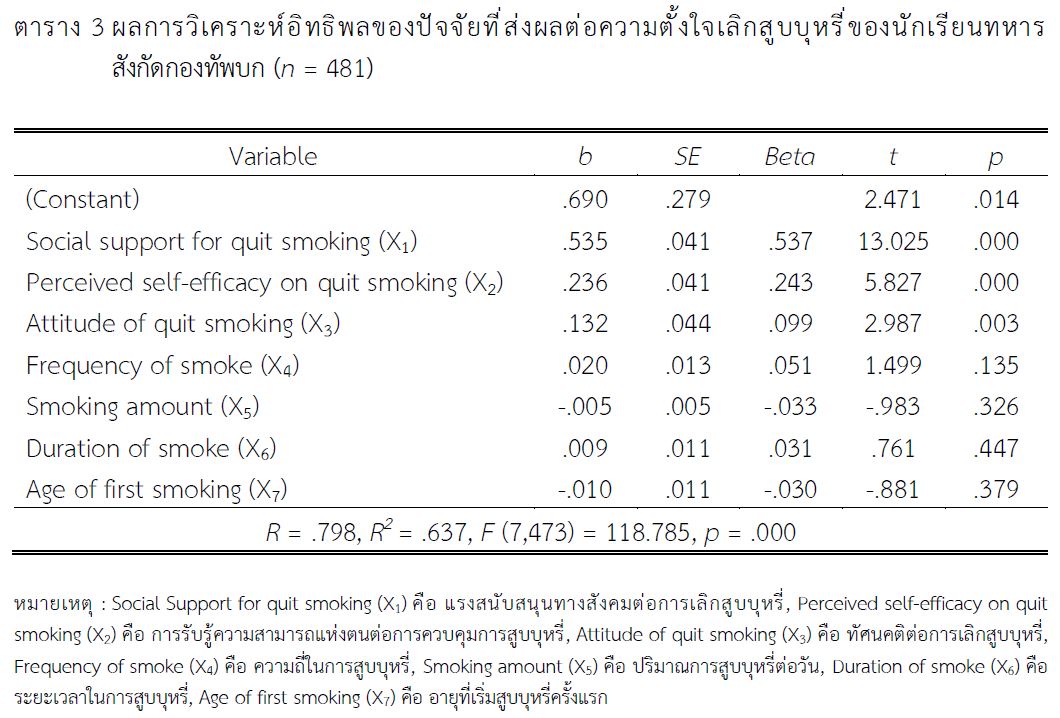ปัจจัยที่มีอิทธิพลต่อความตั้งใจเลิกสูบบุหรี่ของนักเรียนทหาร สังกัดกองทัพบก
คำสำคัญ:
ความตั้งใจเลิกบุหรี่, แรงสนับสนุนทางสังคม, การรับรู้ความสามารถแห่งตน, ทัศนคติต่อการเลิกสูบบุหรี่, นักเรียนทหารบทคัดย่อ
การวิจัยเชิงทำนายนี้ มีวัตถุประสงค์เพื่อศึกษาพฤติกรรมการสูบบุหรี่และปัจจัยที่มีอิทธิพลต่อความตั้งใจเลิกสูบบุหรี่ของนักเรียนทหาร สังกัดกองทัพบก ตัวอย่าง คือ นักเรียนทหารในสถาบันการศึกษา สังกัดกองทัพบก ปีการศึกษา 2565 จำนวน 481 คน ซึ่งเป็นผู้ที่สูบบุหรี่หรือเคยสูบบุหรี่ที่ได้มาจากการสุ่มอย่างง่าย เครื่องมือวิจัยเป็นแบบสอบถามปัจจัยที่มีอิทธิพลต่อความตั้งใจเลิกสูบบุหรี่ (แบบออนไลน์) จำนวน 48 ข้อ มีค่าดัชนีความสอดคล้องระหว่างข้อคำถามกับวัตถุประสงค์ตั้งแต่ .67 ขึ้นไป และมีค่าสัมประสทธิ์แอลฟาของครอนบาทเท่ากับ .907 วิเคราะห์ข้อมูลส่วนบุคคลด้วยสถิติเชิงพรรณนาและการวิเคราะห์การถดถอยพหุคูณด้วยวิธี Enter
ผลการวิจัยพบว่า 1) นักเรียนทหารรายงานว่าเริ่มสูบบุหรี่ครั้งแรกเมื่ออายุ 16 - 18 ปี (ร้อยละ 49.50, M = 17.02 ปี, SD = 2.38) จำนวนบุหรี่ที่สูบต่อวันอยู่ในช่วง 1 - 10 มวน/วัน (ร้อยละ 83.60 , M = 5.49 มวน/วัน, SD = 5.75) ระยะเวลาสูบบุหรี่อยู่ในช่วงเวลา 2 - 5 ปี (ร้อยละ 45.30, M = 3.74 ปี, SD = 2.85) สาเหตุหลักในการสูบบุหรี่ครั้งแรกเกิดจากความต้องการสูบบุหรี่ด้วยตนเองและอยากรู้อยากลอง (ร้อยละ 45.7) ประเภทของการสูบบุหรี่ที่พบมากที่สุด คือ สูบบุหรี่มวน (39.10 %) สูบบุหรี่ไฟฟ้าร่วมกับบุหรี่มวน (ร้อยละ 34.30) และสูบบุหรี่ไฟฟ้า (ร้อยละ 22.90) ตามลำดับ ความถี่ของการสูบบุหรี่พบมากที่สุด คือ สูบทุกวัน (ร้อยละ 48.20) การรับรู้ด้านทัศนคติความสามารถของตนเอง แรงสนับสนุนทางสังคม และความตั้งใจเลิกสูบบุหรี่ อยู่ในระดับมาก 2) อายุที่เริ่มสูบบุหรี่ครั้งแรก ปริมาณการสูบบุหรี่ต่อวัน ความถี่ในการสูบบุหรี่ ระยะเวลาในการสูบบุหรี่ แรงสนับสนุนทางสังคมในการเลิกสูบบุหรี่ การรับรู้ความสามารถแห่งตนต่อการควบคุมการสูบบุหรี่ และทัศนคติต่อการเลิกสูบบุหรี่ สามารถร่วมกันทำนายหรืออธิบายความแปรปรวนของความตั้งใจในการเลิกสูบบุหรี่ของนักเรียนทหาร สังกัดกองทัพบก ได้ร้อยละ 63.70 อย่างมีนัยสำคัญทางสถิติ (R = .798, R2 = .637, F (7,473) = 118.785, p = .000)
ดังนั้น สถาบันการศึกษา สังกัดกองทัพบก และหน่วยงานต้นสังกัดควรให้ความสำคัญในการจัดกิจกรรมส่งเสริมการเลิกสูบบุหรี่ของนักเรียนทหาร เช่น การจัดบริการคลินิกเลิกบุหรี่ หรือการจัดกิจกรรมรณรงค์เลิกสูบบุหรี่ในโรงเรียน การสร้างความตระหนักรู้เกี่ยวกับผลเสียของบุหรี่ไฟฟ้า และการจัดหาทรัพยากรเพื่อสนับสนุนช่วยเหลือ
ผู้ที่ต้องการเลิกบุหรี่
Downloads
เอกสารอ้างอิง
Ajzen, I. (1991). The theory of planned behavior. Organizational Behavior and Human Decision Processes, 50, 179-211. https://doi.org/10.1016/0749-5978(91)90020-T
Boonpen, P., Mentara, P., & Boonpen, P. (2019). E-Cigarettes behavior and smoking cessation behavior of youth smoker in Higher Education Institute, Bangkok. Srinakharinwirot Research and Development (Journal of Humanities and Social Sciences), 11(22), 111-127.
Buddanoi, T., Chanaboon, S., & Kankhwao, B. (2019). Smoking behavior of secondary a casestudy of one school in Khonkean Municipality at Mung, Khonkaen. Journal of Health Science and Community Public Health, 2, 139-152.
Bunkerd, T., Keawsri, N., Authai, T., Laengtong, N., Sakhuntod, P., Ket-ngam, S., Jaiman, H., Wongsorn, A., & Chaitiang, N. (2022). Factors related to smoking behavior of people in Mae Ka Subdistrict, Phayao Province. UBRU Journal for Public Health Research, 11(1), 42–52.
Flay, B., & Petraitis, J. (1994). The theory of triadic influence: A new theory of health behavior with implications for preventive interventions. Advances in Medical Sociology, 4, 19-44.
Jinaphan, N. (2021). Factors associated with willingness to stop smoking of NCDs patients In the Sam Ngam district Phichit Province. Phichit Public Health Research And Academic Journal, 2(2), 8-19.
Kawsiso, M., Homsin, P., & Srisuriyawet, R. (2021). Predicting factors of multiple risk behaviors among male adolescents in Lopburi Province. Thai Red Cross Nursing Journal, 14(1), 140-155.
Lapyai, S. (2019). New tobacco products on social media and law enforcement on new tobacco products control. Public Health Policy and Laws Journal, 5(1), 13-29.
National Statistical Office. (2017). The smoking and drinking behavior survey 2017. Pimdeekarnpim.
Paha, K., & Prechawong, S. (2014). Attitudes, subjective norms, perceive behavioral control, and intention to quit smoking in Police Officers. Journal of The Police Nurses, 6(1), 157-169.
Parinyarux, P., Tajai, P., Chanwuthinun, A., & Ditsawanon, P. (2022). Influence of information on e-cigarette smoking behaviors and decisions. Disease Control Journal, 48(3), 539-550.
Punyakunlaset, S., Chansatitporn, N., & Vatanasomboo, P. (2019). Factors affecting level of intention to quit smoking among Police Officers in the Central Region, Thailand. Journal of Health Science, 28(6), 1029-1039.
Tobacco Control Research and Knowledge Management Center. (2021). Report on the situation of tobacco consumption in Thailand 2019. Sintaveekit.
Yangpaksee, P., Srithongphet, J., Chaiyakiat, C., Bundit, N., Chayakul, T., Eangchuan, N., . . . Kongyoo, S. (2019). Factors predicting the intention to quit smoking among military officers in Bangkok. Thai Journal of Nursing, 68(2), 9-16.
World Health Organization (WHO). (2021). WHO report on the global tobacco epidemic 2021: Addressing new and emerging products. Executive summary. Geneva.

ดาวน์โหลด
เผยแพร่แล้ว
รูปแบบการอ้างอิง
ฉบับ
ประเภทบทความ
สัญญาอนุญาต
ลิขสิทธิ์ (c) 2024 วารสารพยาบาลตำรวจ

อนุญาตภายใต้เงื่อนไข Creative Commons Attribution-NonCommercial-NoDerivatives 4.0 International License.
ผลงานที่ได้ตีพิมพ์แล้วจะเป็นลิขสิทธิ์ของวารสารพยาบาลตำรวจ














